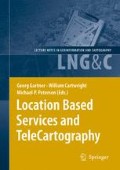Abstract
This paper describes some aspects of mobile positioning accuracy when using mobile positioning data in geographical studies. The method used in Estonia is named the Social Positioning Method (SPM) and uses locations of mobile phones and the personal characteristics of phone owners for studying human behaviour. Positioning experiments conducted in Tallinn and Tartu since 2003 have shown that SPM data facilitates the successful analysis of the space-time behaviour of society. The calculations of theoretical positioning error based on 180 000 positioning measurements in the Estonian GSM network (CGI+TA positioning method) in 2004 showed that 61 percent of positioning points are accurate to within 1000 meters in urban areas and 53 percent are accurate to within 3000 meters in rural areas. Accuracy checks conducted using GPS showed that 52 percent of positioning points are accurate to within 400 meters in urban areas and 50 percent are accurate to within 2600 meters in rural areas. While some of the research findings are limited because of the low accuracy of the positioning data, many research directions, which use a smaller scale such as commuting and regional development studies are nevertheless very promising.
Access this chapter
Tax calculation will be finalised at checkout
Purchases are for personal use only
Preview
Unable to display preview. Download preview PDF.
References
Adams PM, Ashwell GWB, Baxter R. 2003. Location-based services — an overview of standards. BT Technology Journal, 21(1), 34–43.
Ahas R, Mark Ü. 2005. Location based services — new challenges for planning and public administration? Futures, 37(6): 547–561.
Ahas, R., Aasa, A., Mark, Ü., Pae, T., Kull, T. 2006. Seasonal tourism spaces in Estonia: case study with mobile positioning data. Tourism Management (Published online July 2006).
Ahonen S. Eskelinen P. 2003. Mobile terminal location for UMTS. IEEE Aerospace and electronic systems magazine, 18(2): 23–27.
Asakura, Y. and Hato, E. 2004. Tracking survey for individual travel behaviour using mobile communication instruments, Transportation Research C 12: 273–291.
Ericsson 2003. Mobile Positioning Guide. On-line: http://www.ericsson.com/mobilityworld/
Laineste L. 2003. Mobiilpositsioneerimise täpsus ja rakendatavus. Institute of Geography, University of Tartu, Master Thesis, 75 p.
Mannings R, Pearson I. 2003. ‘Virtual Air’ — A novel way to consider and exploit LBS with AR. Journal of the Communications Network, 2(1): 29–33.
Mountain, D. & Raper, J. 2001. Modelling human spatio-temporal behaviour: a challenge for location-based services. Proc. of the 6th Internat. Conference on GeoComputation (pp 24–26). Brisbane, Australia: University of Queensland.
Ohmori N, Harata N, Nakazato M 2005. GPS Mobile phone-based activity diary survey. The 6th International Conference of Eastern Asia Society for Transportation Studies-Gearing Up for Sustainable Transportation in Eastern Asia. Bangkok 21–24 September.
Positium 2006. Social Positioning System. www.positium.ee. Last visited 28.08.2006.
Regio 2006. ReachU Pin-Point Mgine. www.regio.ee. Last visited 28.08.2006.
Spinney JE. 2003. Mobile positioning and LBS applications. GEOGRAPHY 88(4): 256–265.
Author information
Authors and Affiliations
Editor information
Editors and Affiliations
Rights and permissions
Copyright information
© 2007 Springer-Verlag Berlin Heidelberg
About this chapter
Cite this chapter
Ahas, R., Laineste, J., Aasa, A., Mark, Ü. (2007). The Spatial Accuracy of Mobile Positioning: Some experiences with Geographical Studies in Estonia. In: Gartner, G., Cartwright, W., Peterson, M.P. (eds) Location Based Services and TeleCartography. Lecture Notes in Geoinformation and Cartography. Springer, Berlin, Heidelberg. https://doi.org/10.1007/978-3-540-36728-4_32
Download citation
DOI: https://doi.org/10.1007/978-3-540-36728-4_32
Publisher Name: Springer, Berlin, Heidelberg
Print ISBN: 978-3-540-36727-7
Online ISBN: 978-3-540-36728-4
eBook Packages: Earth and Environmental ScienceEarth and Environmental Science (R0)

